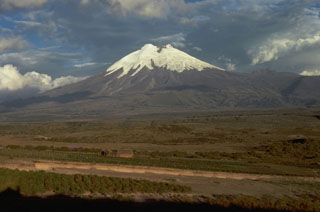Report on Cotopaxi (Ecuador) — 2 September-8 September 2015
Smithsonian Institution / US Geological Survey
Weekly Volcanic Activity Report, 2 September-8 September 2015
Managing Editor: Sally Sennert.
Please cite this report as:
Global Volcanism Program, 2015. Report on Cotopaxi (Ecuador) (Sennert, S, ed.). Weekly Volcanic Activity Report, 2 September-8 September 2015. Smithsonian Institution and US Geological Survey.
Cotopaxi
Ecuador
0.677°S, 78.436°W; summit elev. 5911 m
All times are local (unless otherwise noted)
IG reported that during the morning on 2 September gas-and-steam plumes from Cotopaxi contained minor amounts of ash, rose 100 m above the crater, and drifted W and NW. At about 1318, plumes with moderate amounts of ash rose 4 km and drifted W. Ashfall was reported in Machachi, Aloasí, and Chaupi. Analysis of ash collected on 2 September showed that the greatest contribution of material was pre-existing and altered rock. On 3 September ash-and-water-vapor plumes rose 2.2 km and drifted N and NW. During an overflight scientists observed ash emissions that rose 1 km and drifted W then N; the plume continued to rise to 8.5 km as it drifted N. Several new cracks in the glaciers were noted, especially on the E and NE flanks. Blocks had been deposited on the N and S parts of the crater. The circular glacier at the top of the inside part of the crater had significantly decreased in size and had large fractures. Glacial melting on the upper flanks had also accelerated. Streams of meltwater were present on the N flank. Thermal images revealed temperature increases in the S and E parts of the crater and a significant increase in temperatures of emissions (200 degrees Celsius). Seismic amplitudes did not increase but signals 3-11 km deep aligned with the conduit suggested rising magma. Bright areas at the summit were observed at night, possibly from hot block deposits. During 4-8 September gas-and-ash plumes rose 1 km at most and drifted N and NW.
Geological Summary. The symmetrical, glacier-covered, Cotopaxi stratovolcano is Ecuador's most well-known volcano and one of its most active. The steep-sided cone is capped by nested summit craters, the largest of which is about 550 x 800 m in diameter. Deep valleys scoured by lahars radiate from the summit of the andesitic volcano, and large andesitic lava flows extend to its base. The modern edifice has been constructed since a major collapse sometime prior to about 5,000 years ago. Pyroclastic flows (often confused in historical accounts with lava flows) have accompanied many explosive eruptions, and lahars have frequently devastated adjacent valleys. Strong eruptions took place in 1744, 1768, and 1877. Pyroclastic flows descended all sides of the volcano in 1877, and lahars traveled more than 100 km into the Pacific Ocean and western Amazon basin. Smaller eruptions have been frequent since that time.
Source: Instituto Geofísico-Escuela Politécnica Nacional (IG-EPN)

